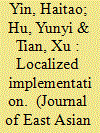|
|
|
Sort Order |
|
|
|
Items / Page
|
|
|
|
|
|
|
| Srl | Item |
| 1 |
ID:
094870


|
|
|
|
|
| Publication |
2010.
|
| Summary/Abstract |
The passing of the Renewable Energy Law (REL) in 2005 demonstrated China's commitment to renewable energy development. In the 3 years after the REL, China's renewable electricity capacity grew rapidly. From 2006 to 2008, China's wind capacity installation more than doubled every year for 3 years in a row. However, three facts prevent us from being optimistic about China's renewable electricity future. First, considered as a share of total capacity, renewable electricity capacity is decreasing instead of increasing. This is due simply to the rapid growth of fossil fuel capacity. Second, a significant amount of renewable generation capacity is wasted because it is not connected to the electricity grid. Finally, renewable electricity plants are running at a low level of efficiency. Based on an in-depth analysis of China's existing renewable energy policy, we suggest that these challenges should be dealt with by introducing a market-based mandatory renewable portfolio requirement coupled with strong regulatory monitoring of grid enterprises.
|
|
|
|
|
|
|
|
|
|
|
|
|
|
|
|
| 2 |
ID:
094399


|
|
|
|
|
| Publication |
2010.
|
| Summary/Abstract |
Several US states have passed renewable portfolio standard (RPS) policies in order to encourage investment in renewable energy technologies. Existing research on their effectiveness has either employed a cross-sectional approach or has ignored heterogeneity among RPS policies. In this paper, we introduce a new measure for the stringency of an RPS that explicitly accounts for some RPS design features that may have a significant impact on the strength of an RPS. We also investigate the impacts of renewable portfolio standards on in-state renewable electricity development using panel data and our new measure of RPS stringency, and compare the results with those when alternative measures are used. Using our new measure, the results suggest that RPS policies have had a significant and positive effect on in-state renewable energy development, a finding which is masked when design differences among RPS policies are ignored. We also find that another important design feature - allowing "free trade" of REC's - can significantly weaken the impact of an RPS. These results should prove instructive to policy makers, whether considering the development of a federal-level RPS or the development or redesign of a state-level RPS.
|
|
|
|
|
|
|
|
|
|
|
|
|
|
|
|
| 3 |
ID:
104977


|
|
|
|
|
| Publication |
2011.
|
| Summary/Abstract |
With economic development and the change of industrial structure, industrial relocation is an inevitable trend. In the process of industrial relocation, environmental externality and social cost could occur due to market failure and government failure. Little attention has been paid to this issue. In this paper, we address it with a theoretical analysis and an empirical investigation on the relationship between China's industrial relocation in the early 1990s and energy consumption which is the primary source of CO2 emission, an environmental externality that causes increasing concerns. The macro-policy analysis suggests that there would be a positive link between China's industrial relocation in the early 1990s and energy saving (and environmental externalities reduction). Using fixed-effect regression model and simulation method, we provide an empirical support to this argument. In order to further reduce environmental externalities and social cost in the process of industrial relocation, we provide policy suggestions as follows: First, strengthen the evaluation of environmental benefits/costs; Second, pay more attention to the coordinated social-economic development; Third, avoid long-lived investment in high-carbon infrastructure in areas with industries moved in; Fourth, address employment issue in the areas with industries moved out.
|
|
|
|
|
|
|
|
|
|
|
|
|
|
|
|
| 4 |
ID:
181840


|
|
|
|
|
| Summary/Abstract |
China's overcapacities in manufacturing industries, including pollution-intensive industries, served as an important motivation of the Belt and Road Initiative (BRI). The popular Pollution Haven Hypothesis (PHH) therefore expects that the initiative will lead to the relocation of polluting industries from China to the recipients. Focusing on the implementation by local governments, we argue that actual outcomes of the BRI depend on the way local states and businesses respond to the BRI in accordance with their preferences. Through investigating industries’ actual responses to the BRI, we found that pollution-intensive industries have not relocated but rather expanded exports to the BRI countries. This has two implications: on the one hand, it alleviates the overcapacity issue in China and helps sustain the economic performance of the industry; on the other hand, it results in more pollution within Chinese borders and aggravates the environmental challenges facing the country.
|
|
|
|
|
|
|
|
|
|
|
|
|
|
|
|
|
|
|
|
|